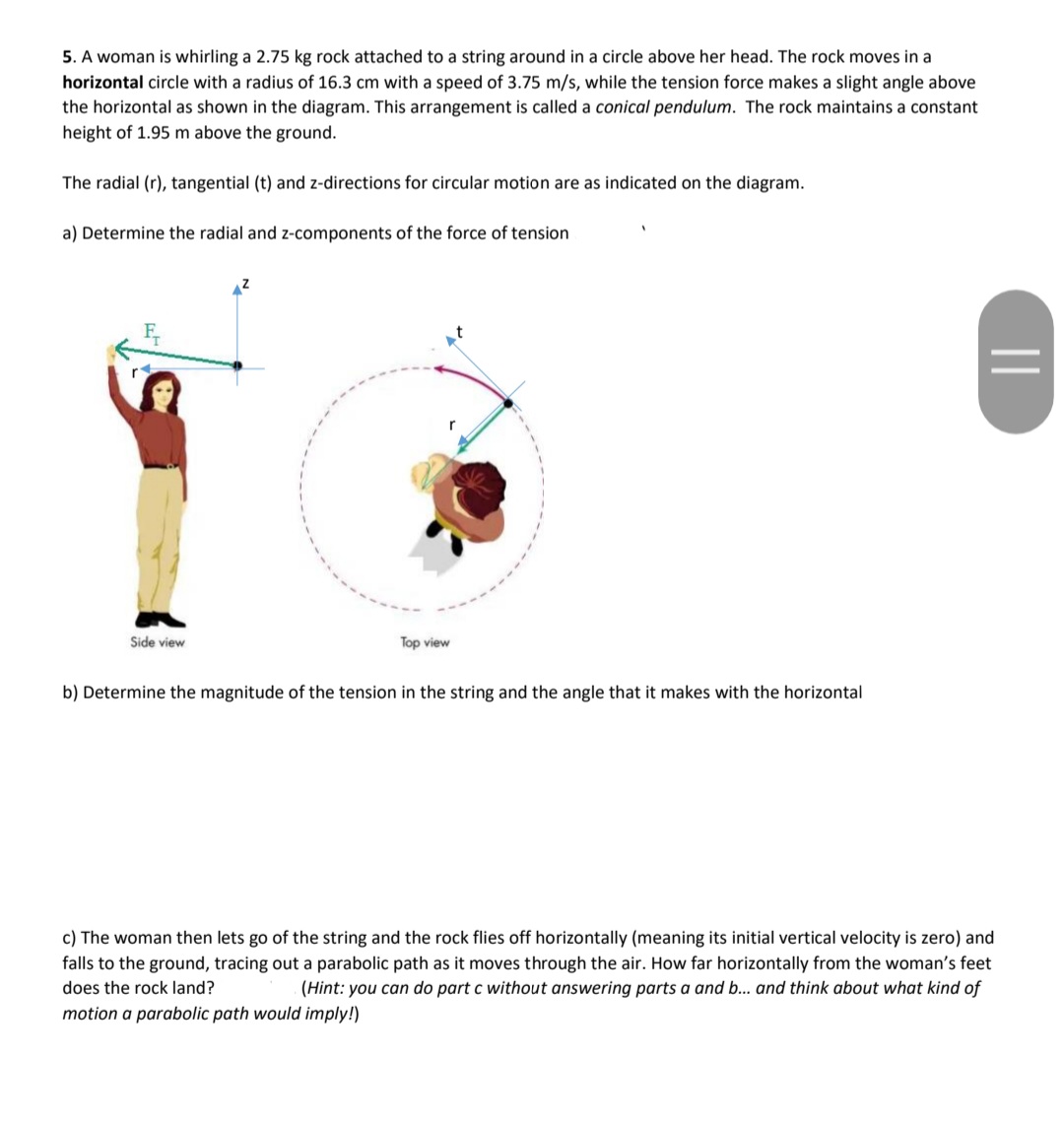5. A woman is whirling a 2.75 kg rock attached to a string around in a circle above her head. The rock moves in a horizontal circle with a radius of 16.3 cm with a speed of 3.75 m/s, while the tension force makes a slight angle above the horizontal as shown in the diagram. This arrangement is called a conical pendulum. The rock maintains a constant height of 1.95 m above the ground. The radial (r), tangential (t) and z-directions for circular motion are as indicated on the diagram. a) Determine the radial and z-components of the force of tension Side view Top view b) Determine the magnitude of the tension in the string and the angle that it makes with the horizontal c) The woman then lets go of the string and the rock flies off horizontally (meaning its initial vertical velocity is zero) and falls to the ground, tracing out a parabolic path as it moves through the air. How far horizontally from the woman's feet (Hint: you can do part c without answering parts a and ... and think about what kind of does the rock land?
5. A woman is whirling a 2.75 kg rock attached to a string around in a circle above her head. The rock moves in a horizontal circle with a radius of 16.3 cm with a speed of 3.75 m/s, while the tension force makes a slight angle above the horizontal as shown in the diagram. This arrangement is called a conical pendulum. The rock maintains a constant height of 1.95 m above the ground. The radial (r), tangential (t) and z-directions for circular motion are as indicated on the diagram. a) Determine the radial and z-components of the force of tension Side view Top view b) Determine the magnitude of the tension in the string and the angle that it makes with the horizontal c) The woman then lets go of the string and the rock flies off horizontally (meaning its initial vertical velocity is zero) and falls to the ground, tracing out a parabolic path as it moves through the air. How far horizontally from the woman's feet (Hint: you can do part c without answering parts a and ... and think about what kind of does the rock land?
Physics for Scientists and Engineers with Modern Physics
10th Edition
ISBN:9781337553292
Author:Raymond A. Serway, John W. Jewett
Publisher:Raymond A. Serway, John W. Jewett
Chapter8: Conservation Of Energy
Section: Chapter Questions
Problem 28AP: Why is the following situation impossible? A softball pitcher has a strange technique: she begins...
Related questions
Question

Transcribed Image Text:5. A woman is whirling a 2.75 kg rock attached to a string around in a circle above her head. The rock moves in a
horizontal circle with a radius of 16.3 cm with a speed of 3.75 m/s, while the tension force makes a slight angle above
the horizontal as shown in the diagram. This arrangement is called a conical pendulum. The rock maintains a constant
height of 1.95 m above the ground.
The radial (r), tangential (t) and z-directions for circular motion are as indicated on the diagram.
a) Determine the radial and z-components of the force of tension
Side view
Top view
b) Determine the magnitude of the tension in the string and the angle that it makes with the horizontal
c) The woman then lets go of the string and the rock flies off horizontally (meaning its initial vertical velocity is zero) and
falls to the ground, tracing out a parabolic path as it moves through the air. How far horizontally from the woman's feet
(Hint: you can do part c without answering parts a and b... and think about what kind of
does the rock land?
motion a parabolic path would imply!)
||
Expert Solution
This question has been solved!
Explore an expertly crafted, step-by-step solution for a thorough understanding of key concepts.
This is a popular solution!
Trending now
This is a popular solution!
Step by step
Solved in 4 steps

Knowledge Booster
Learn more about
Need a deep-dive on the concept behind this application? Look no further. Learn more about this topic, physics and related others by exploring similar questions and additional content below.Recommended textbooks for you

Physics for Scientists and Engineers with Modern …
Physics
ISBN:
9781337553292
Author:
Raymond A. Serway, John W. Jewett
Publisher:
Cengage Learning

Principles of Physics: A Calculus-Based Text
Physics
ISBN:
9781133104261
Author:
Raymond A. Serway, John W. Jewett
Publisher:
Cengage Learning

Physics for Scientists and Engineers
Physics
ISBN:
9781337553278
Author:
Raymond A. Serway, John W. Jewett
Publisher:
Cengage Learning

Physics for Scientists and Engineers with Modern …
Physics
ISBN:
9781337553292
Author:
Raymond A. Serway, John W. Jewett
Publisher:
Cengage Learning

Principles of Physics: A Calculus-Based Text
Physics
ISBN:
9781133104261
Author:
Raymond A. Serway, John W. Jewett
Publisher:
Cengage Learning

Physics for Scientists and Engineers
Physics
ISBN:
9781337553278
Author:
Raymond A. Serway, John W. Jewett
Publisher:
Cengage Learning